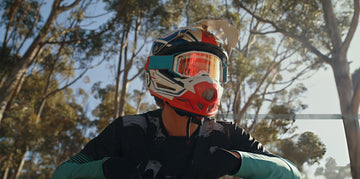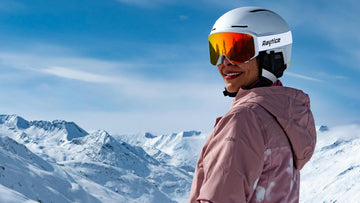A clear vision is crucial for smoothly skiing or snowboarding on the slopes. However, many skiers and snowboarders struggle to navigate the trails while riding. Ski goggles with the right lens color help you offer better visibility. It also helps you avoid potential obstructions.
Lens colors filter particular wavelengths, boost contrasts, and reduce glare. It makes it convenient to spot changes in the snow surface. Different lens colors are meant for optimal performance in varying conditions. In this snow goggle lens color guide, we'll help you choose the best color for every condition. So, let's get into it.
Why Lens Color Matters in Ski Goggles?
Lens color in ski goggles looks stylish. However, it's not just about style. They boost the performance of your goggles. Ski goggles lenses are necessary to prevent strain while crossing snowy terrains. They also boost visibility in specific weather conditions. The following is an overview of why lens color is significant:
Filtering Light
Ski goggles filter various light wavelengths and manage brightness levels. Different lens colors block some wavelengths, allowing only particular ones to pass through. It improves visibility by controlling glare and enhancing contrast.
Improving Depth Perception
Navigating terrain and spotting handles are crucial for smoothly skiing or snowboarding. The right lens color for ski goggles offers better depth perception. It enables you to evaluate distances and navigate the slopes. Enhanced depth perception minimizes the risks of accidents. It also boosts your confidence while moving on the slope.
Enhancing Visibility
The lens color impacts your vision in different environments. It adjusts the contrast and brightness. It also facilitates the recognition of various details in snowy terrains.
Protection Against UV Radiations
Skiing at high altitudes makes your eyes more susceptible to UV radiation. A WHO report shows that UV radiation levels increase by 10% after every 1000-meter rise in altitude. The color and coating of goggle lenses block UV radiation and safeguard your eyes.
Best Lens Colors for Different Light and Weather Conditions
Various lens colors are suitable for different situations. Each lens color promotes visibility in certain conditions. Different lens colors allow particular wavelengths to cross. This feature improves contrast and depth perception for skiing or snowboarding.
You can explore our snowboard and ski goggles with different lens colors. We present unique lens colors that promote clarity. Whether you are a cyclist or a snowboarder, choosing the right lens color ensures an enjoyable experience. Here are some common goggle lens colors that you can opt for skiing:
Yellow and Gold Lenses
Gold and yellow ski goggles offer better contrast than other colors. It makes them a great solution for visibility under overcast skies or late afternoon runs. They are also the best ski goggle lens for flat light. They enhance brightness on foggy or cloudy days. You can also utilize these lens colors for indoor sports.
They filter blue light and create a sharp contrast. They also enable you to spot various bumps and dips. In addition, these colors are the best choice for detecting mobile objects. Moreover, gold and yellow ski goggles brighten dim light conditions. These low-light ski goggles prevent eye strain, which results from focusing in poor light conditions.
Brown and Amber Lens
Amber and brown ski goggles block more blue light than yellow and orange ski goggles. These lens colors are a great choice for variable light conditions. They offer sufficient visibility on sunny and partly cloudy days. They enhance natural colors, making it easier to spot uneven terrain. Brown and amber ski goggles provide a balance between glare reduction and brightness enhancement.
Rose and Pink Lenses
Pink and red ski glasses and goggles lens colors are known to offer better depth perception. They block blue light to help you see things when altering light conditions. In addition, rose and pink goggles ski boost contrast. It enables snowboarders to navigate the rough path. They minimize light glare. It makes them an effective solution for comfortable vision during bright conditions.
These colors are the best solution for places with variable landscapes, like snow-covered hills. You can use them for skiing during cloudy days or snowy conditions.
Blue and Purple Lenses
Blue and purple lens colors minimize excessive glare during harsh sunlight. This feature filters intense light, reducing harsh reflections from snow. It also reduces eye fatigue during prolonged exposure. These colors also block ultraviolet radiation, protecting your eyes. Moreover, they maintain a natural color balance, helping you perceive your surroundings accurately.
These features make them suitable for fishing, water sports, and hiking. You can also employ them to ski in various light conditions, including sunny or foggy days. They are also good choices if you are going snowboarding in snowy conditions.
Gray and Black Lenses
These lenses reduce overall brightness without altering the perception of natural colors. It makes them ideal for maintaining color accuracy in all weather conditions. Whether you are going skiing on a bright sunny day or in outdoor activities, you should wear goggles with gray or black lenses.
Snowboard goggles with these lens colors minimize light intensity. Their neutral tint helps preserve natural visibility. They keep you from excessive brightness in high-light environments. Moreover, they shield your eyes from UV radiation. It makes them best for prolonged exposure to sunlight and snow reflection.
Mirrored Lenses
Mirrored ski goggles lenses offer exceptional glare protection by reflecting sunlight. The reflected coating reduces the light entering the lens. It improves comfort and visibility in environments with bright or direct sunlight.
These lenses are effective in protecting against harmful UV rays. They also minimize eye fatigue during prolonged exposure to bright light. It helps you maintain focus and comfort throughout your activities.
How to Choose the Right Ski Goggle Lens Color for Your Needs
Choosing the right ski goggle lens color is not an easy pursuit. You need to consider several factors to ensure optimal visibility and comfort on the slopes.
Consider the Weather Conditions You Ski In
Weather conditions can affect your skiing experience. Understanding the impact of lens color is necessary for comfortable visibility. Before choosing a lens tint, you need to think about the conditions you'll encounter.
Lens Color for Bright Conditions
You need a lens color that reduces glare for bright and sunny days. They should also filter out intense light. A goggle with dark dark-colored lens is best suited for bright conditions. It's best to use dark gray, brown, or red lenses.
Lens Color for Low-Light Conditions
Goggles or Low or flat-light conditions, like cloudy day ski goggles, demand lenses with better depth perception. These lenses also brighten your view. You should opt for amber, yellow, pink, or light rose lenses. These lens colors are best for buying goggles and sunglasses for cloudy days. These light tints improve contrast and enhance visibility.
Lens Color for Snowy Conditions
For snowy weather, you'll need versatile lenses that adapt to changing conditions. You should go with photochromic lenses as they adjust to varying light conditions. These lenses darken in bright light and lighten in low-light environments. In addition, goggles with interchangeable lenses give you the flexibility to switch lenses based on the weather.
Understand VLT (Visible Light Transmission)
Visible light transmission (VLT) refers to the quantity of light that passes through a goggle lens. It significantly affects your visibility in various conditions.
A VLT under 20% is considered low. It is best for skiing in bright conditions, as it minimizes glare and enhances comfort in intense sunlight.
Ski goggles with medium VLT between 20% and 40% are ideal for cloudy or mixed conditions. They provide sufficient light by balancing light filtration and visibility.
Do you know what VLT range would be best for flat light conditions? High VLT lenses (above 40%) are recommended for overcast days or low-light skiing. They permit enough light to reach your eyes. High VLT lenses are also integrated into night skiing goggles to improve clarity.

Think About Lens Material and Coatings
The materials and coatings of ski goggles influence their performance. They also influence their durability and visibility. High-quality lens materials are essential to provide excellent impact resistance. They also ensure comfort during prolonged use. Here are some materials and coatings you should consider:
- Polycarbonate lenses are recognized for their lightweight and scratch resistance. These features make them suitable if you frequently encounter rough conditions. They have multi-layer construction. These layers include anti-scratch coatings, anti-fog coatings, and UV protection. They enhance their performance and provide optical clarity.
- Acetate lenses are known for their excellent optical clarity. They are also resistant to fogging. In addition, these lenses maintain a clear view in cold and humid conditions.
- Polyurethane lenses are flexible and resilient to freezing temperatures. They are a great solution for skiing in cold conditions. Polyurethane is also impact-resistant. It can absorb and dissipate impact forces and reduce the risk of lens damage from sudden shocks or falls.
- An anti-fog coating prevents condensation while skiing. This feature is essential as fogging can affect visibility. It can help you maintain clear visibility during intense physical activity.
- Ski goggles with UV coating block ultraviolet rays. They prevent your eyes from damaging the effects of these radiations.
- The hydrophobic coating also improves ski goggles' performance. It prevents moisture from accumulating on the lens. In addition, it helps maintain a clear view in wet and snowy conditions.
Get Your Desired Lens Color Ski Goggles With Raytice
Selecting the right ski goggle lens color is essential for clear vision. It enhances your comfort and protects your eyes during skiing or snowboarding adventures. Each lens color works in particular conditions. Every color has specific properties, from yellow and pink to brown ski goggles.
The right lens color can help you reduce glare on sunny days. It also improves contrast in low-light conditions. Weather, VLT, and various materials and coatings can also impact your lens performance. Pay attention to these factors when choosing the best ski goggle lens. So, invest in the appropriate lens and boost your skiing and snowboarding experience.
Many skiers and snowboarders struggle to get high-end goggles with different lens colors. Not all manufacturers offer the best quality. If you are looking for high-end snow goggles, Ratice is the best choice.
Raytice is devoted to developing quality goggles and sunglasses with quality lens at budget-friendly prices. Our goggles and sunglasses are crafted with premium Zeiss lens, providing various color options for you to wear in different weather condition. You can also explore our sunglasses for getting outdoor experience in cloudy days or intense light conditions.








